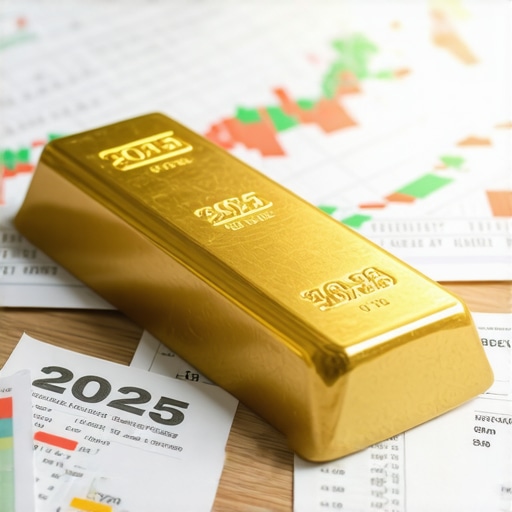Strategic Gold Investment in 2025: Unlocking the Power of ETFs and Mutual Funds
As the global economic landscape becomes increasingly complex, diversifying investment portfolios with gold-based assets remains a prudent strategy for seasoned investors. In 2025, the focus on Gold ETFs and Mutual Funds offers sophisticated avenues for wealth preservation and growth, leveraging the metal’s intrinsic value and hedge capabilities against inflation and market volatility.
Assessing the Evolving Landscape of Gold Investment Vehicles
How do Gold ETFs and Mutual Funds Compare in the Context of Diversified Growth?
Gold ETFs provide liquid exposure to gold prices without the need for physical storage, enabling nimble tactical adjustments. Conversely, gold mutual funds often encompass a diversified basket of gold-related assets, including mining stocks and physical gold, offering a balanced approach to risk management. Understanding the nuances of these vehicles is essential for constructing resilient portfolios tailored to 2025’s macroeconomic trends.
Key Factors Shaping Gold Investment Strategies in 2025
Several macroeconomic elements influence gold’s performance, including central bank policies, geopolitical tensions, and inflationary pressures. Notably, central bank gold purchases are expected to significantly impact prices, emphasizing the importance of strategic allocation in gold ETFs and mutual funds. Additionally, supply-demand dynamics, especially in the jewelry and technology sectors, will continue to influence market trends.
Expert-Recommended Gold ETFs and Mutual Funds for 2025
Leading financial analysts suggest focusing on funds with low expense ratios, transparent holdings, and robust liquidity. For instance, the SPDR Gold Shares (GLD) remains a cornerstone ETF, while actively managed mutual funds like the Fidelity Select Gold Portfolio offer diversified exposure with professional oversight. Incorporating these instruments can enhance portfolio resilience amid volatile economic conditions.
What Advanced Strategies Can Maximize Gold’s Role in a Diversified Portfolio?
Leveraging gold demand trends and technical analysis, investors can fine-tune entry and exit points, optimizing returns. Combining ETF liquidity with mutual fund diversification enables a nuanced approach to risk management, especially during periods of market upheaval.
For a comprehensive overview of safe investment practices, consider exploring safe methods of purchasing physical gold. Engaging with expert insights and advanced analytical techniques can significantly elevate investment outcomes in 2025.
As the landscape evolves, continuous education and strategic agility remain paramount.
Interested in further expert analyses? Dive into our detailed guides on top gold ETFs and mutual funds for diversified growth in 2025 and contribute your insights to the global investment community.
Unlocking the Full Potential of Gold in 2025: Advanced Strategies for Investors
As the global economy continues to navigate uncertainties, savvy investors recognize the importance of refining their gold investment strategies to maximize returns. In 2025, understanding the nuanced interplay of macroeconomic factors, market dynamics, and technical analysis can significantly enhance portfolio performance. Are you leveraging the right tools and insights to stay ahead in this evolving landscape?
How Can Investors Use Technical Analysis to Identify Optimal Entry and Exit Points?
Technical analysis remains a cornerstone for timing gold trades effectively. By studying chart patterns, moving averages, and momentum indicators, investors can pinpoint high-probability entry and exit points. For instance, the use of gold futures technical analysis can reveal short-term trends that align with long-term investment goals, enabling strategic positioning amid volatility.
What Role Do Global Economic Trends Play in Shaping Gold Prices?
Understanding macroeconomic variables such as inflation rates, currency fluctuations, and geopolitical tensions is vital. Experts suggest that global economic factors significantly influence gold’s performance, often acting as catalysts for price movements. For instance, rising inflation or currency devaluation typically drive investors toward gold as a safe haven, underscoring the importance of staying informed about international economic indicators.
Are we truly prepared for the next major market upheaval, and how can gold serve as a safeguard?
Gold’s role as a hedge against market turbulence is well-established, but the effectiveness of this strategy depends on timing and allocation. Expert analyses emphasize the need for a diversified approach, blending physical gold, ETFs, and mining stocks to create a resilient portfolio. For practical tips on building such a diversified approach, visit developing a profitable gold portfolio. Additionally, understanding supply-demand dynamics, especially in the jewelry and technology sectors, can provide early signals for potential price shifts.
Interested in practical tools for optimizing your gold investments? Explore using gold futures technical analysis to refine your trading strategies. Remember, continuous education and strategic agility are crucial to navigating the complexities of the gold market effectively.
For further expert insights and detailed analysis, consider reviewing our comprehensive guides on top gold coins and bars for wealth preservation and top gold mining stocks for growth in 2025. Share your thoughts and strategies in the comments below to foster a community of informed and prepared investors.
Harnessing the Power of Macro and Microeconomic Indicators for Precision Gold Trading
In the realm of sophisticated gold investment, a nuanced understanding of macroeconomic indicators—such as inflation rates, currency devaluation, and global geopolitical shifts—is paramount. Yet, equally critical is the analysis of microeconomic factors like mining output, technological advancements, and regional political stability. Integrating these layers of data enables investors to anticipate price movements with greater accuracy, thus transforming reactive strategies into proactive, data-driven decisions.
Integrating Quantitative Models with Fundamental Analysis for Optimal Timing
Quantitative analytical models—ranging from machine learning algorithms to neural networks—are increasingly being employed to decode complex market signals. When combined with traditional fundamental analysis, these models offer a formidable toolkit for identifying optimal entry and exit points. For example, predictive analytics can detect subtle shifts in supply-demand dynamics, while fundamental insights confirm the broader economic narratives supporting these signals. This synergy enhances risk management and maximizes return potential.
Addressing the Nuances of Gold Price Volatility: Strategies for the Modern Investor
Gold markets are inherently volatile, driven by a confluence of unpredictable geopolitical events, policy shifts, and speculative trading. Advanced investors counter this volatility through sophisticated hedging techniques such as options strategies, futures contracts, and dynamic asset allocation. For instance, employing collar strategies—where a combination of puts and calls—can protect gains during downturns while maintaining upside exposure. Continual monitoring of technical indicators like Bollinger Bands and the Relative Strength Index (RSI) allows for agile adjustments aligned with market sentiment shifts.
What are the implications of central bank digital currencies (CBDCs) on gold demand and pricing?
Emerging CBDCs could redefine traditional monetary frameworks, potentially influencing gold’s role as a safe haven. According to the Bank of International Settlements’ 2024 report, the advent of CBDCs might increase global liquidity transparency, impacting gold’s appeal as a non-sovereign store of value. Investors should monitor policy developments and technological integrations related to CBDCs, as these could either diminish or amplify gold’s hedging effectiveness depending on regulatory and economic responses.
For a deeper dive into these complex dynamics, explore authoritative resources such as the BIS Report on CBDCs and monetary policy. Staying ahead in the gold market requires not only understanding current trends but also anticipating future disruptions—making continuous education and strategic flexibility indispensable.
Engage with our community by sharing your insights or querying specific strategies. For tailored advice and comprehensive analyses, consider subscribing to our expert-led webinars and in-depth reports on next-generation gold investment tactics. Your proactive engagement today sets the foundation for resilient wealth preservation tomorrow.
Emerging Quantitative Techniques: How Can Data Science Revolutionize Gold Trading?
The integration of sophisticated data science methodologies, such as machine learning algorithms and artificial intelligence, is transforming gold trading strategies. These tools analyze vast datasets—from macroeconomic indicators to sentiment analysis on social media—to identify subtle market patterns and predict short-term price movements with unprecedented accuracy. For example, neural networks trained on historical price data and real-time news feeds can generate predictive signals that outperform traditional technical analysis, offering traders a competitive edge in volatile markets.
The Impact of Geopolitical Shifts: What Role Do Global Power Dynamics Play in Shaping Gold Prices?
Geopolitical tensions, such as conflicts, trade disputes, and shifts in international alliances, directly influence investor sentiment and safe-haven demand for gold. Analyzing geopolitical risk indices alongside political stability measures enables investors to anticipate potential surges in gold prices. Notably, recent developments in regions with strategic resource significance or unstable governance can trigger abrupt market reactions, emphasizing the need for dynamic risk assessment models integrated into investment decisions.
What Is the Significance of Blockchain Technology in Transforming Gold Investment Transparency?
Blockchain technology promises to enhance transparency, traceability, and security in gold transactions. By leveraging decentralized ledgers, investors can verify the provenance of physical gold holdings and ensure ethical sourcing, thereby reducing fraud and increasing confidence. Moreover, tokenization of gold assets facilitates fractional ownership and improved liquidity, enabling more flexible portfolio management and potentially unlocking new markets for gold investments.
How Can Investors Leverage Macro-hedging Strategies to Protect Against Currency Fluctuations?
Macro-hedging involves deploying currency derivatives, such as options and futures, to mitigate exposure to foreign exchange risk in international gold holdings. Advanced investors often use cross-hedging techniques, selecting instruments correlated with their base currency, to stabilize returns amid volatile FX markets. Incorporating these strategies within a comprehensive asset allocation framework ensures resilience against currency devaluation, especially in emerging markets where monetary policies are rapidly changing.
To deepen your understanding of these cutting-edge approaches, consult authoritative sources like the IMF Report on Data Analytics and Blockchain in Financial Markets. Staying ahead requires continuous learning and strategic adaptation—explore these insights to refine your investment tactics for 2025 and beyond.
Engage with our expert community by sharing your experiences or asking questions about implementing these advanced strategies. Subscribe to our exclusive webinars and reports for ongoing updates on next-generation gold investment techniques tailored for sophisticated investors.
Expert Insights & Advanced Considerations
1. The Role of Quantitative Models in Gold Trading
Integrating machine learning algorithms and neural networks allows investors to decode complex market signals, enhancing timing accuracy for entry and exit points, thereby optimizing returns in volatile conditions.
2. Geopolitical Risks as Price Catalysts
Analyzing global power shifts, conflicts, and trade disputes helps anticipate surges in gold prices, emphasizing the importance of dynamic risk assessment models for proactive investment strategies.
3. Blockchain for Transparency and Security
Blockchain technology increases gold transaction transparency and traceability, supporting ethical sourcing and fractional ownership, which fosters liquidity and portfolio flexibility.
4. Macro-Hedging Strategies
Employing currency derivatives and cross-hedging techniques mitigates FX risks in international holdings, ensuring resilience against currency devaluation and monetary policy shifts.
5. Advanced Technical Analysis Tools
Using Bollinger Bands, RSI, and futures technical analysis can reveal short-term trends, enabling strategic positioning during market upheavals and enhancing portfolio robustness.
Curated Expert Resources
- IMF Report on Data Analytics and Blockchain in Financial Markets: Offers insights into how emerging technologies are transforming gold trading and investment transparency.
- Bank of International Settlements (BIS) Reports: Provides comprehensive analyses on CBDCs and their potential impact on gold’s role as a safe haven asset.
- Academic Journals on Quantitative Finance: Delivers advanced methodologies on integrating machine learning and neural networks into market analysis.
- Financial Market Data Platforms: Real-time analytics tools that support technical and macroeconomic analysis for informed decision-making.
- Industry Conferences and Expert Webinars: Opportunities for networking, learning about cutting-edge strategies, and understanding future market trends.
Final Expert Perspective
As we navigate 2025, the nuanced understanding of gold investment—blending macroeconomic insights with micro-level data, technological advances, and sophisticated risk management—becomes essential for discerning investors. Harnessing these expert strategies not only optimizes portfolio resilience but also positions you at the forefront of the evolving gold market. Engage deeply with authoritative resources, contribute your insights, and stay agile—your proactive approach today will secure the wealth preservation and growth of tomorrow.










